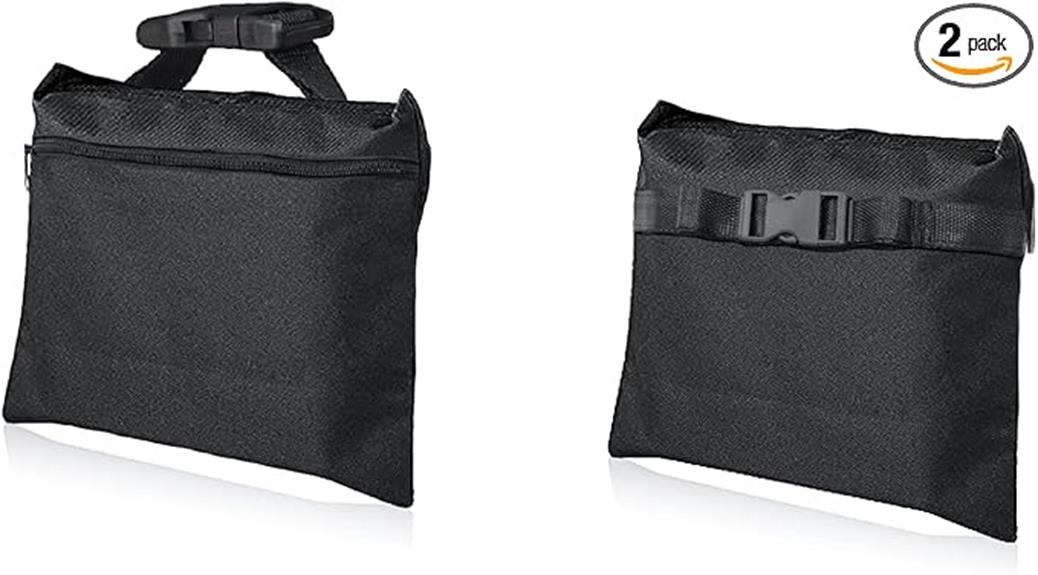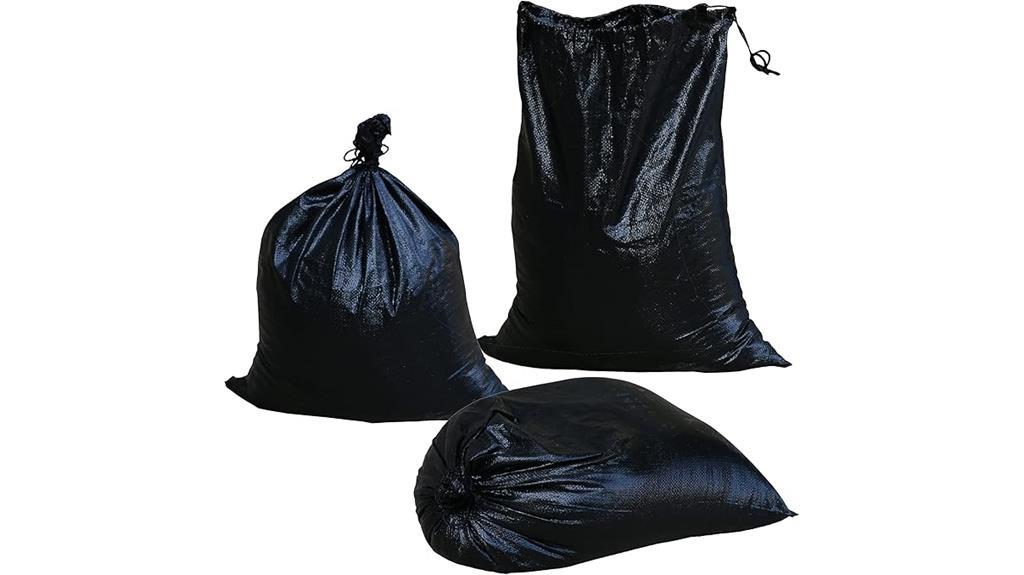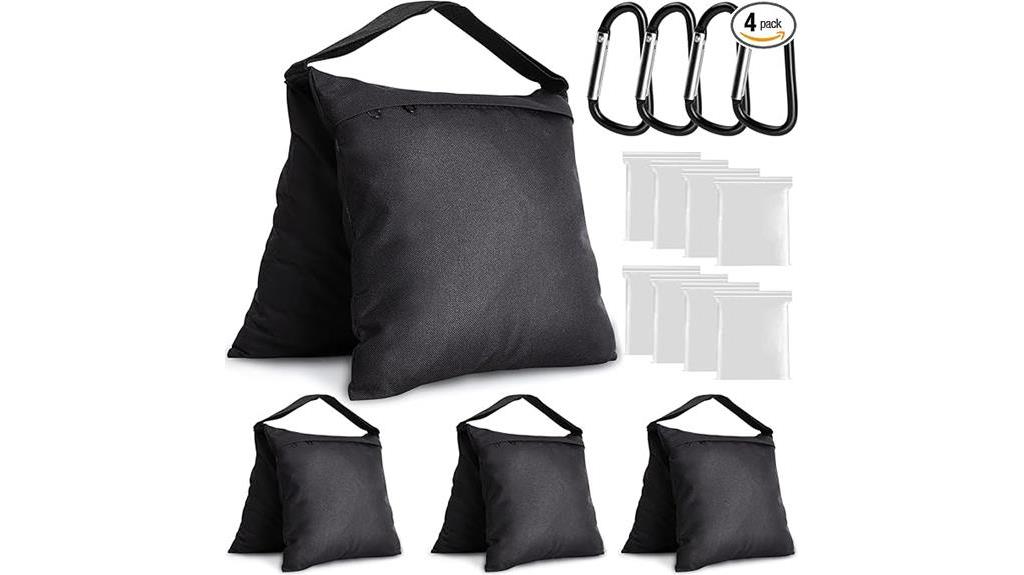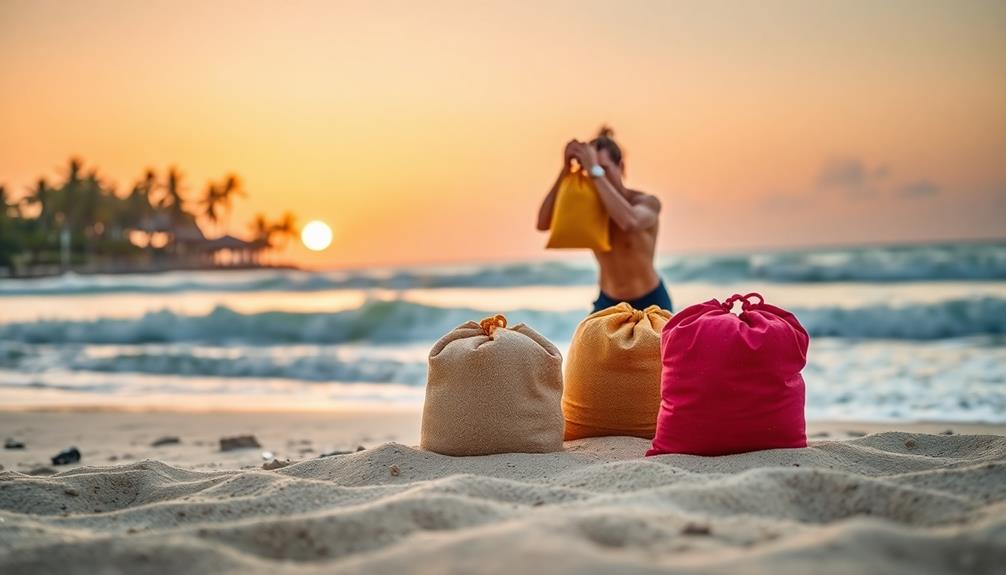As you gear up for your beach workouts in 2024, you'll want to guarantee you're using the best equipment to maximize your training. Sand resistance bags have become increasingly popular for their versatility and ability to challenge even the fittest athletes. But with so many options on the market, how do you choose the right one? We've narrowed down the top three sand resistance bags that'll take your beach workouts to the next level. These bags offer durability, security, and convenience, making them perfect for intense seaside training sessions. Let's explore what sets these options apart and why they're the best choices for your beach fitness routine.
2 Packs Heavy Duty Sandbags with Zipper and Buckle Straps

If you're a fitness enthusiast looking for reliable and versatile equipment for your beach workouts, the 2 Packs Heavy Duty Sandbags with Zipper and Buckle Straps are a great choice. These sandbags provide stability in different environments and can also serve as resistance training tools for your outdoor sessions.
Using these bags is simple. They feature buckle straps that allow for easy hanging without needing any hooks. With various pack sizes available, you can pick the one that matches your workout intensity. Made from durable Oxford cloth, these sandbags are built to last, and the zipper makes it easy to fill them with sand right from the beach.
Keep in mind that some users have mentioned concerns about the strength of the straps when the bags are filled to the max. To enhance durability, consider filling the bags partially or mixing sand with lighter materials. Each bag has a maximum load capacity of 8 lbs, providing enough resistance for a solid beach workout.
Best For: Fitness enthusiasts seeking portable resistance equipment for beach workouts and outdoor training.
Pros:
- Made from durable Oxford cloth for long-lasting use
- Easy to fill with sand thanks to the zipper design
- Suitable for a range of exercises and resistance levels
Cons:
- Some users report strap strength issues when fully loaded
- The maximum load capacity of 8 lbs may not be enough for advanced users
- Included PE bags may not be the best quality
These sandbags are a practical option for anyone wanting to enhance their beach workout experience.
Black Empty Sandbags for Flood Water Barrier and Construction (19 x 24)

Looking for versatile gear for your beach workouts? Check out these Black Empty Sandbags. While they are mainly made for flood barriers and construction, they can also be great for fitness enthusiasts.
Here's why you should consider them:
- Durability: Made from 100% Virgin Polyethylene, these bags are tough enough to handle beach workouts.
- Size and Capacity: Measuring 19 x 24 inches, they can hold up to 55 lbs of sand, making them suitable for different exercise levels.
- UV Resistance: With 3-year sun protection, these bags will endure many beach sessions.
- Easy to Use: The tie-strings help keep the sand in place during your workouts.
Though they aren't specifically designed for fitness, their adaptability makes them a budget-friendly choice for beach exercises. Just keep in mind that some users have reported tearing after several uses, so handle them carefully to extend their life.
Best For: Beach fitness lovers looking for affordable, versatile equipment for sand workouts.
Pros:
- Strong construction with 100% Virgin Polyethylene material
- Large capacity (up to 55 lbs) for different workout intensities
- UV-resistant for lasting outdoor use
Cons:
- Not specifically made for fitness purposes
- Some users reported tearing after multiple uses
- May need careful handling to ensure they last longer
Aimosen Sandbags Weight Bags for Photography Equipment (4 Packs)

Photography lovers and outdoor workers will find the Aimosen Sandbags Weight Bags very useful. These sturdy saddlebags help keep your equipment steady, whether you're using backdrop stands or setting up pop-up tents. The package includes four sandbags, four aluminum clips, and eight PE sealed bags, giving you plenty of options for your setup.
To use the bags, just fill the PE sealed bags with sand or gravel and place them inside the sandbags. Made from durable oxford fabric with a PVC coating, these bags are built to last. They also feature dual zippers for added security, so if one zipper fails, you have a backup. However, while they work well for studios and light outdoor use, some users have raised concerns about their long-term durability in tough conditions, so consider this if you plan to use them often at the beach or in other challenging areas.
Best For: Photographers, videographers, and outdoor event organizers looking for reliable and portable ways to stabilize their equipment.
Pros:
- Versatile design suitable for many uses, from photography stands to outdoor furniture
- Comes with multiple components (sandbags, clips, PE sealed bags) for flexible use
- Dual zipper design offers extra security if one zipper fails
Cons:
- Sandbags are sold empty, meaning you'll need to fill them with sand or gravel yourself
- Some users have concerns about long-term durability in harsh outdoor conditions
- May not be ideal for heavy-duty use or extreme weather situations
Factors to Consider When Choosing Sand Resistance Bags

When you're in the market for sand resistance bags, you'll want to keep several key factors in mind. Consider the bag's material durability, weight capacity, size and dimensions, closure mechanism, and UV resistance to guarantee you're getting the right fit for your beach workouts. Let's explore these important aspects to help you make an informed decision that'll enhance your fitness routine in the sand.
Material Durability
When choosing sand-resistant bags for beach workouts, material durability is key. You want your bag to last against sun, sand, and surf. Here are some important points to consider:
- Material Composition:
- Look for bags made from 100% Virgin Polyethylene (PE) for great durability.
- Heavy-duty Oxford cloth is also a good choice for outdoor use, as it's resistant to wear.
- Reinforcement:
- Choose bags with reinforced seams to keep sand from leaking and to help the bag last longer.
- Thicker materials usually mean better durability and the ability to be used multiple times.
- Protective Coatings:
- PVC-lined Oxford fabric improves the feel of the bag and helps resist moisture.
- UV-resistant materials can handle up to 3 years of direct sunlight without significant damage.
- Weight Capacity:
- Check the safe working load (SWL) rating; a higher rating often means stronger materials.
- Larger bags with a 55 lb SWL are designed to handle more weight and pressure.
Weight Capacity
When choosing sand resistance bags for beach workouts, weight capacity is crucial. This factor tells you how much sand or gravel the bag can hold without breaking.
Weight capacities can differ a lot. You can find lightweight bags that hold about 8 lbs, and heavy-duty options that can handle up to 55 lbs. Here are some things to consider when picking the right capacity for you:
- Intended use: Will you be doing light resistance training or more intense strength workouts?
- Filling material: Remember that sand is heavier than some other options, so keep that in mind.
- Your strength level: Choose a weight you can lift comfortably, but also consider your potential for growth.
The bag's construction is also important. Bags made from thicker, tear-resistant materials usually have higher weight limits. Think of it like this: a grocery bag and a moving box can both hold items, but you wouldn't use a flimsy bag to carry heavy books.
Size and Dimensions
The size of your sand resistance bag can greatly impact your workout at the beach. Here are some key factors to consider when choosing the right dimensions:
- Workout Intensity: If you plan to do intense strength training, go for a larger bag (about 19 x 24 inches) that can hold up to 55 lbs. For lighter exercises or if you're just starting out, a smaller bag (around 7.4 x 3.54 x 2.05 inches) is a better choice.
- Portability: Make sure the bag is easy to carry to the beach. You don't want to struggle dragging a heavy bag through the sand!
- Versatility: Pick a size that can accommodate different exercises. A medium-sized bag can work well for both upper and lower body workouts.
- Ease of Use: Look for bags with wide openings and secure closures. This will help prevent any sand spills during your workout.
- Storage: Think about where you'll store the bag when it's not in use. If space is tight, a compact size might be best.
Closure Mechanism
Once you've chosen the right size for your sand resistance bag, it's time to think about the closure mechanism. This feature is crucial for your beach workout experience. You'll want a closure that is secure, easy to use, and durable enough to handle sand-filled training.
The most common closure options are zippers and tie-strings. Here's a quick overview:
- Zipper closures:
- Allow easy access for refilling or adjusting your bag
- Provide a secure seal to keep sand from leaking out
- Look for dual zippers for added durability
- Tie-string closures:
- Take more effort to secure tightly
- May not hold up as well over time, especially with heavy loads
For beach workouts, where you'll be tossing and swinging your sand bag, a zipper closure is often the better choice. It acts like a reliable partner that won't fail you mid-exercise. Make sure the closure matches your workout style. If you plan to do intense beach HIIT sessions, choose a strong closure to prevent any spills.
UV Resistance
Ultraviolet rays can damage your sand resistance bags if you're not careful. When picking a bag for your beach workouts, make sure it has UV resistance. Here's why it's important and what to look for:
- Longevity: UV-resistant bags can last up to 3 years, even with regular sun exposure. That means you're getting three bags for the price of one!
- Durability: Sun damage can weaken your bag, leading to tears or leaks. UV resistance helps keep your bag strong and effective.
- Material: Choose bags made from 100% Virgin Polyethylene (PE). This material is designed to handle tough UV rays and different weather conditions.
- Versatility: UV-resistant bags are not just for the beach. They're also great for construction sites, flood barriers, or outdoor events where sun exposure is high.
Ease of Filling
When choosing sandbags for your beach workouts, it's important to think about how easy they are to fill. Here are some key points to consider:
- Wide Openings: Look for bags with large openings. This makes it easy to pour in sand or gravel, saving you time and hassle.
- PE Sealed Bags: Choose sandbags with polyethylene liners. These liners stop sand from leaking and keep the filling process neat.
- Secure Closures: Go for bags with strong ties or zippers. This ensures your sand stays inside and prevents spills during your workout.
- Weight Considerations: Think about how heavy the bag will be when filled. Lighter bags can be easier to handle, especially if they can hold a lot of sand.
- Durable Materials: Select bags made from strong fabrics like oxford cloth. They will last through repeated use without tearing.
Strap Strength
When choosing a sand resistance bag, strap strength is key. You want a bag that will hold up while you work out on the beach. Here are some important factors to consider:
- Heavy-duty buckle straps: Look for straps that can securely hold the bag. Not all straps are equally strong, so check reviews to see how they perform when the bag is full.
- Maximum load capacity: The weight limit of the bag often indicates how strong the straps are. For example, if the bag can hold 8 lbs, the straps should be able to handle that weight without any issues.
- Material quality: The material of the straps plays a big role in their durability. Cheap materials can break or fray, especially in windy conditions. You want to avoid any surprises during your workout.
- Long-term durability: Think about how the straps will hold up over time. Some bags may start off strong but can wear out after several uses. Choose a bag that is built to last.
Intended Use Compatibility
When choosing sand resistance bags for your beach workouts, it's important to find the right fit for your needs. Here are a few key factors to consider:
- Weight Capacity: Make sure the bag can hold enough weight for your workout. For intense training, look for bags like the Black Empty Sandbags, which can carry up to 55 lbs. This ensures your equipment can handle the demands of your routine.
- Material and Size: Choose bags made from strong materials like Oxford cloth or polyethylene. These can withstand the wear from sand and saltwater. Also, consider the size of the bag. A 19 x 24 inch bag is a good option for exercises like lunges and squats.
- Ease of Use: Look for features that make the bag easy to use, such as tie-strings or zippers.
- User Reviews: Check reviews to see how well the bags perform in beach workouts.
Frequently Asked Questions
Can Sand Resistance Bags Be Used for Indoor Workouts?
Yes, you can absolutely use sand resistance bags for indoor workouts. They're versatile tools that'll challenge your muscles in unique ways. You'll find them great for strength training, core exercises, and even cardio routines within your home or gym.
How Often Should Sand Resistance Bags Be Replaced?
You should replace your sand resistance bags every 6-12 months, depending on usage frequency and intensity. If you notice wear, tears, or leaks, replace them immediately. Regular inspections will help you maintain their safety and effectiveness.
Are Sand Resistance Bags Suitable for Beginners?
Yes, sand resistance bags are suitable for beginners. You'll find them versatile and adjustable, allowing you to start with lighter loads. They're great for building strength and stability, and you can easily progress as you get stronger.
Can You Fill Sand Resistance Bags With Materials Other Than Sand?
Yes, you can fill sand resistance bags with other materials. You'll find options like rice, pebbles, or even water work well. However, sand remains the most popular choice due to its texture and weight distribution properties.
Do Sand Resistance Bags Come in Different Weight Capacities?
Yes, you'll find sand resistance bags in various weight capacities. They're typically available from 10 to 100 pounds. You can choose the weight that suits your fitness level and workout goals. Some bags even offer adjustable weights.

